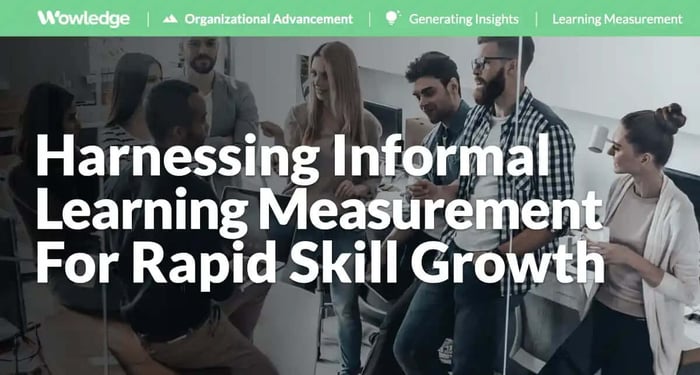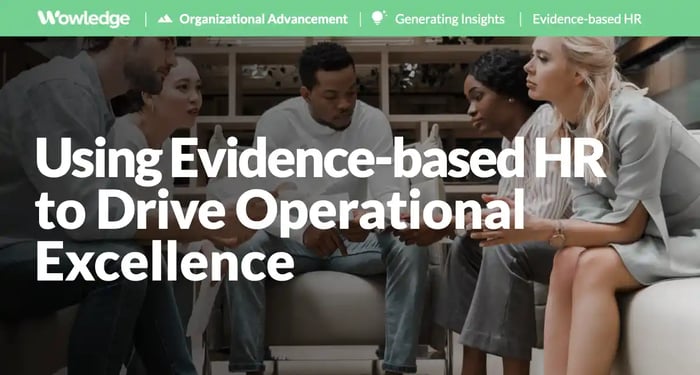Table of Contents
Learning Measurement represents a critical opportunity to assess the quality and impact of L&D offerings, but it also presents its share of challenges for L&D teams. The imperative to move beyond overly simplistic metrics related to participation rates, completions, and learner satisfaction (“smile sheets”) has existed for years, yet it still confounds many professionals. The continued growth and reliance on informal learning, which occurs outside of a traditional classroom or instructor-led environment, complicates things. Understanding its value and impact through informal learning measurement has become a priority for L&D leaders and their teams.
Research confirms the informal learning measurement challenges facing many organizations. Brandon Hall Group reports that fewer than 16% of companies can identify and track metrics that reveal the efficiency, effectiveness, talent, or business impact of any learning activity (formal or informal). Similarly, its earlier studies found that 60% of organizations are “not at all effective” at measuring informal learning, with 52% equally ineffective at measuring experiential learning activities.
Given the demonstrated talent and business value of experiential development, combined with business impact measurement across HR functions, informal learning measurement can provide substantial upsides for organizations. Such development activity appears to be a standard approach for most workers, with reports finding that 94% of employees rely upon it for knowledge growth and skill acquisition. Interestingly, 50% of surveyed workers said they learn something new daily through informal means such as reading articles, books, or videos.
Defining informal learning
Before developing measures, organizations should clearly state what is and is not informal learning. While many definitions are promoted, most are overly simplistic and lead to confusion about what constitutes it. Informal learning is not simply an unplanned, self-initiated activity. It is any job-related learning and development activity initiated by an employee (or a manager or peer with topical expertise), involving action and reflection, with the purposeful intention of developing their knowledge or skills.
The activity can include education (context, key concepts), illustration (demonstration, applications), or instruction (how to perform) about a topic. It may or may not be embedded in daily work activities, as with employee learning outside the workplace and work hours. It may also be structured (or semi-structured) and planned, with frameworks, guides, or tools designed to guide employees in the optimal practice or participation in otherwise in-the-moment acts of coaching, practice, experimentation, or mentoring.
The range of activities is seemingly endless, but has been identified to include the search or request for feedback, help, or information, from a wide range of internal and external sources, including subject matter experts, experienced leaders, peers, academic or industry researchers, and industry futurists. Types of informal learning include many options, which can be unique or freestanding activities, or overlapping across categories, such as:
- On-demand (search, books, articles, videos, podcasts, knowledge management portals, and prior project summaries)
- Social (blogs, expert directories and locators, communities of practice, coaching and mentoring, collaboration platform postings and question submissions, and lunch-and-learn sessions)
- Workflow-embedded (job aids/support, performance feedback, project planning and “post-mortems”, on-the-job coaching, and skill or technique refinement)
- Experiential (work assignments, special project teams, job rotations, job shadowing, and simulations or practice “runs”)
- Exposure (conferences, expert speakers and authors, executive meeting attendance, strategic planning session observation, internal and external networking)
The value and realities of measuring informal learning
Given the reported prevalence of informal learning and its value-add to continuous learning and skill development in a rapidly changing environment, informal learning offers unique power as a skill-building method. As the World Economic Forum (WEF) projects that 39% of current job skills will become obsolete in the coming 5 years, tracking and assessing all learning and development activities offer certain advantages. They can:
- Enable identification of the most effective upskilling and reskilling activities.
- Identify more cost-effective knowledge and skill development solutions.
- Help managers and employees leverage the most job-relevant (and therefore more engaging) methods of growth.
- Increase the focus on and attention to the value of collaborative supervisor, project manager, and peer-based knowledge transfer activities while supporting related efforts to increase managerial and peer coaching and mentorship.
- Broaden the adoption and application of best-practice job skills to increase individual or work team productivity and performance levels.
At the same time, however, many organizations report barriers to more meaningful informal learning measurement (e.g., actual behavioral change, skill application, impact on business outcomes). The reasons will sound familiar to any experienced HR or L&D professional:
- Don’t have the proper metrics (42% of surveyed companies)
- Don’t have the time or qualified staff (42%)
- Lack of technology to support (36%)
- Too hard to link learning to business outcomes (35%)
- Too difficult to assess (31%)
While these issues have existed for years, a significant imperative for better measurement of all learning and skill development strategies has emerged from combining the WEF skills obsolescence projections with the rapid global adoption of AI technologies to help counter shrinking labor pools and enhance productivity. Addressing informal learning measurement must be included, particularly given the preponderance of rapidly advancing learning technologies that already exist (estimated at 77%) in U.S. corporations that can collect, track, and report on learning activities.

Developing an informal learning measurement strategy and supporting capability
Creating a comprehensive informal learning measurement capability that generates helpful guidance and direction for enhancing the impact of enterprise learning and development calls for a structured approach. The effort starts with a clear definition of what is to be measured, the purpose and value to be attained, the methods that will be employed, the tools and technology to be leveraged, and the creation of metrics and analyses that drive decision-making. The capability should be designed to take advantage of existing resources, simplify data collection, be non-bureaucratic, and motivate employees to adopt.
1. Clarify what is to be measured
Articulating a definition of informal learning that will be applied across the organization is a key starting point, as many definitions are used across experts from academics, consulting firms, and industry thought leaders. While those differences may be slight and nuanced, each organization must clearly define informal learning, including what is included and what is not, so the measurement can be guided and structured consistently. Two targets for informal learning measurement provide a foundation for all subsequent data collection and tracking, with each giving essential insights into what employees are learning about, how they are accessing those, and their impact or relative value.
- Learning activity. Data related to this generates an understanding about the kinds of learning that employees are engaging in, the sources, the frequency of their use, the length of time engaged with each, the portion of workers who rely upon them, and the emergence of different types and sources.
- Level of proficiency. Any assessment of learners’ knowledge and skill levels generated during or after completing a course, certification program, or related programming (internally or externally provided) offers additional information related to a) program participation and completion, and b) the level of attained expertise. Such data can be generated by capturing skill checks in eLearning or certification program modules, post-program skills testing, and analyzing top-performing or skilled learners’ informal learning activities relative to increased competency or skill proficiency level ratings.
2. Understand the learning process
Identify the activities and resources used to develop their knowledge and skills. Collect insights from learners about their informal learning practices and sources to generate an initial understanding of what they use and how (and when) they decide to use each. Conduct surveys or focus groups with targeted learner groups that cut across and create a representative sampling of them by function, role, generation, and work location to understand the variety and nuances of their information and learning needs.
The objective is to generate insights into the specific knowledge, skills, or capabilities that current informal learning addresses. Seek to understand what and how learners engage with the learning materials or activities. Best practice calls for further analysis by subdividing them by performance and tenure levels to identify the types, volumes, and frequencies of activities that correlate with higher levels of contribution and longevity.
3. Devise and leverage methods for collecting data
Various methods can be used to collect insights into informal learning. This type of employee learning is often self-initiated based upon an immediate need or longer-term motivation. It can involve interpersonal, digital, and physical (books or manual handling and testing) learning, so multiple data collection vehicles are required. A formal plan should be developed that starts with using existing systems and processes as data sources and then adding others as time and budget allow.
Automated data
Identify and access information collected and reported on from digital learning platforms, including an LMS or LXP. Most platforms offer standardized reporting on course completions, certification programs, and learning object (video, podcast, article) search and review histories.
Data can also be collected from internal knowledge management (e.g., searches, articles accessed) and social and collaboration platforms (e.g., questions, searches, contributions, content views, sharing, likes and dislikes, and peer ratings of their contributions). Organizational network analysis (ONA) can leverage data from emails, collaboration platform posts, and meeting schedules to identify subject matter experts (SMEs) and employees seeking advice and counsel, revealing peer-to-peer social learning.
xAPI, an eLearning data standard or specification that enables the capture and sharing of learning data across different systems, provides an exciting and noninvasive option for data collection. It can automatically capture activities on desktop or mobile devices, such as simulations, work tasks, development activities, and social or collaborative platforms. Embedded mini-surveys can be programmed to “pop up” after viewing an online asset and asking to rate its relevance and usefulness.
Self-report
Leverage or create opportunities for employees to report the full range of learning and development activities they participated in by offering entry forms and fields in centralized HR systems, such as those used with employee profiles, individual development plans (IDSPs), performance management, succession management, or learning management and experience platforms. If a system automatically logs formal learning activities, use these other systems to collect only informal activities to avoid repetitive data collection. The form(s) should have required fields (e.g., activity, description, source, observer/leader name, location, date(s), and hours spent) that can be used to validate their self-reports and evaluate the value of the learning. Skills databases, which are emerging as significant HR systems (or modules), can also be used to collect, analyze, and report on informal learning that is entered as proof of skill acquisition.
Performance assessments
Learner activities and proficiency levels can be accessed from the various performance evaluations they are subject to throughout their careers. Data can be pulled from special project performance assessments and required skills tests, certification demonstrations, and exams. Talent calibration sessions, where groups of managers review and discuss the relative contributions of employees in the same or similar roles and levels, can also provide insights into informal activities. Changes to job responsibilities, assigned stretch goals, promotions, and transfers involve new skill and experiential elements that require indoctrination, education, coaching, and guidance. Managers’ evaluations (of job skills or competencies) can also capture growth in skill or knowledge proficiency (e.g., basic, advanced, or expert), indicating informal learning actions.

Analyzing and using informal learning measurement data
The purpose of any organizational measurement effort is to more objectively understand what is occurring, why, the primary driver(s) of the event or trend, and insights into potential solutions for overcoming, exploiting, or improving the planned or desired operational outcomes. In the same vein, informal learning measurement is designed to understand what employees are using, how effective those are, and which ones are or might be impacting desired talent and business outcomes.
Data collected from various sources (systems, surveys, focus groups) must be compiled in a common data repository, protected from unauthorized viewing or access, reviewed and cleansed to ensure data consistency and quality, and prepared for analysis. Generative AI (e.g., ChatGPT, Claude, Gemini) can be used to rapidly and efficiently summarize and identify themes and details on the sources, circumstances, and purposes of informal learning from focus groups and open response survey items using natural language processing (NLP) and machine learning algorithms.
Analyses should be used to generate insights into not only employee use and sources of informal learning, but also any indications of the relative efficiency, effectiveness, and impact of those activities. The goal is to understand how informal learning contributes to skill and knowledge development, whether it speeds or slows the process, and the relative cost-effectiveness of those activities over (or in combination with) formal instructor-led or e-learning programs. The applications and analytic possibilities are endless, but in general, the primary value and uses for each category of informal learning data include:
- Activity data can be used to understand what employees are doing that can, should, or should not count as learning for individual development credit and what employees are learning so that it can be tracked and measured using automated methods. It can also generate exceptional insights about learner preferences and be used to evaluate each source's quality, accuracy, and reliability, such that recommendations can be made about the value (or lack of) to subsequent learners.
- Proficiency level data related to the post-learning level of expertise or proficiency can be used to assess the effectiveness of participating in any informal learning activity (by itself or in combination with others), resulting in recommendations for future learners. It helps understand the most effective learning assets, resources, or activities that can be used to create learning paths optimized by employee function, level, or role.
Use these data sources to build fundamental analyses of the range and value of informal learning across types (e.g., on-demand, social, experiential) that employees are accessing and participating in, and then compare them across employee groups, locations, functions, and roles. Given such information on employee interests (especially when broken down into employee function and role), decisions can be made about whether the need for increased content related to the most sought-after subject matter exists.
From an operational or business perspective, insights into the topics or subject matter they access are also used to assess the extent to which specific content is aligned with organizational growth plans and related skills gaps or needs. Those can be used to create learning strategies and associated communications that focus employees on specific learning and skill paths for advancement and growth that align with business direction.
The most valuable opportunity to use the activity and proficiency data comes from using those activities as independent variables against which more advanced analyses can be performed using talent or business outcomes as the dependent variables. For example, compare the informal learning activities of top-performers versus all other employees in a predictive (e.g., regression) analysis to determine the extent to which those activities account for differences in subsequent performance evaluation ratings, merit pay, promotion, or retention rates. Another example is performing a similar analysis to understand the extent to which the aggregated informal activities of sales employees in one location might be associated with the outperformance of the sales employees in another location.
Relevant Practices & Tools
Emerging HR Metrics and Reporting Practices to Drive Situation Assessment and Actionable Insights for Managers and Leaders. >
HR Metrics & Reporting is a standardized and structured experience for both developers and users of the data and reports... more »
Creating Informal Learning and Experiential Development Opportunities for Cost-effective Delivery. >
Informal learning is broadly defined as any learning activity that is not learned in a formal class, has no set goals or objectives, and focuses on the enhancement or addition of knowledge, skills, and abilities... more »
Planning Individually Tailored Development for all Identified Successors and HIPOs. >
Once successors and HIPOs for critical roles are approved by top leadership, preparing those individuals for development planning is essential... more »
Incorporating Coaching and Mentoring into Performance Management to Better Engage Employees in their Own Performance. >
Enhancing managerial feedback and coaching is a process informed and driven in part by training and development, in part through feedback, and in part by reinforcement or rewards tied... more »
The Metrics Calculation Guide Tool: Lay Out Metrics and How they are Calculated to Build Consistency of Data's Inputs and Outputs. >
The metric calculation guide is a template that lists the details for each metric to be computed in an HR or related system, database, or spreadsheet and describes the precise method... more »
About Wowledge
Wowledge is the implementation-first platform designed for lean HR teams and consultants who need to design and scale strategic HR programs efficiently—without starting from scratch.
Our members gain access to continuously updated best practices, step-by-step guidance, expert-built tools, and customizable templates—all structured to accelerate the development and implementation of key HR programs.
Recognizing that every organization operates at different levels of sophistication, Wowledge’s scalable system of best practices follows a stage-based approach—Core, Advanced, and Emerging—ensuring HR professionals can implement solutions tailored to their organization’s unique needs and goals.
Your Shortcut to Amplifying HR Impact!
Get started for FREE! Learn more.









